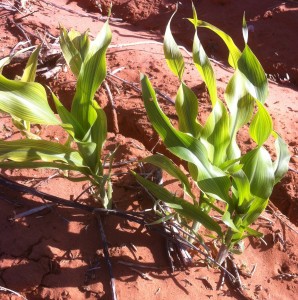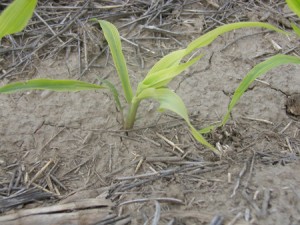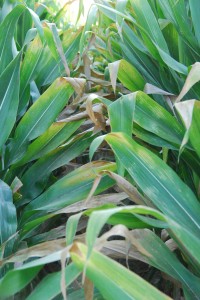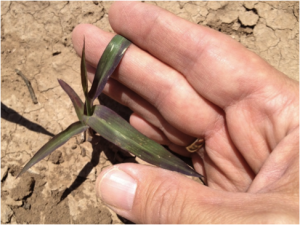Wrapping up the Season – Assessing your Sorghum Crop & Potential Improvement
Statewide
Producers in the Coastal Bend and through much of Central Texas have put their sorghum crop to rest with mixed results. High Plains grain sorghum ranges from through the combine to late-planted crops that are only 2 weeks or so past flowering.
In assessing this year’s crop, drought again has played a major role in most Texas grain sorghum fields. Whether you ascribe to global warming, now more likely called ‘climate change,’ I believe grain sorghum’s role will be reconsidered for many farmers wherever you are in Texas because we can get to grain sorghum production on less water than other grains and the cost of production is lower.
As you look at your 2013 grain sorghum fields for the last few times of the year, where only the stubble remains, the combines are running, you shut the irrigation water off for the last time, or you have your eye on the calendar and the weather forecast looking for one last rain and some warm weather to finish out a late crop, consider these issues as we move toward 2014 cropping:
- What weed control issues am I facing in my grain sorghum? Am I getting good control? Do I need to consider another strategy on pesky weeds?
- Should I have marketed my grain sorghum in 2013 by locking in some production (especially if irrigated)? In hindsight, if I was aware of the $10.50-11.25/cwt. basic contract prices late in 2012, did I truly recognize those prices for what they were—high—and the opportunity they represented? Did I not sign up some of my acres because I thought the already-high prices would get even better? Of course hindsight is always better, know that when sorghum and other crop prices are near their top, we can get “stuck” and end up not doing anything.
- Is my seed drop and target plant population what it should be? Is it possible that my seeding rate is too high (do I have trouble with lodging; does my crop seem to “burn up” too easily)?
- Am I confident that I am making the best choice I can on my hybrid selection? Texas A&M AgriLife hybrid trials are being posted for the 2013 harvest season at http://varietytesting.tamu.edu/grainsorghum/index.htm
- As I look at the stubble from my 2013 grain sorghum crop, what could I do differently to take advantage of these residues for soil conservation, rotation benefits, and moisture capture? Do I need to consider some different coulters, trash whippers, residue managers on my planter so I can leave more of this stubble in place?
- What do I believe is the yield limiting factor in my grain sorghum production? Naturally it may be water for many producers, but if that is the case then how can I improve utilization of the water I do have?
- What further information do I need to improve my management decisions for grain sorghum in 2014?
Economic “Loss” from Selling Low Moisture Grains Due to Excessive Harvest Delay
Statewide
Producers understand the need for timely harvest to minimize potential lodging and the reduction in yield. A hidden loss of gross income, however, comes from delaying harvest well beyond when grain sorghum could be cut and sold closer to (but below) 14% moisture. How can this happen? Your pay weight is not adjusted up for low moisture, so you don’t get to sell water, i.e. any moisture in the seed up to 14% adds to your pay weight.
Example: For grain sorghum the net effect of each 1% moisture content below the standard 14% reduces your effective yield. In this example at $8.50/cwt., the reduction in pounds of grain to sell translates to a $0.098/cwt. penalty per each -1% percent of moisture of drier grain. In this example grain at 10% moisture, the reduction in sale pounds is equivalent to receiving $8.12/cwt. Thus for each 1% moisture below 14% in the harvested grain, every 1,000 lbs./A of grain is worth $0.98/acre less (or $4.90/cwt. less for a 5,000 lbs./A crop at 13% moisture; or $19.20 less per acre for a 10% moisture grain crop). This adds up when you harvest several hundred acres! Obviously we can’t get all the sorghum harvested right at or just under 14%, but let this knowledge lead to take that test cut a little sooner, ensure you have your custom harvester lined up, etc. This crop value differential is sufficient to justify paying a little more for earlier harvest if you can to avoid dry grain in addition to reduced potential lodging losses or storm damage. Harvest aids may help you also manage timely harvest by adding predictability to your harvest timing to capture and sell water as part of your grain.
Are Routine Fungicide Applications for Improved Plant Health Justified in Grain Sorghum?
Statewide
Fungicides are typically used in grain sorghum to control foliar disease when the potential for yield loss is significant. However, some suggest fungicides should be used to improve “plant health”, regardless of disease presence. This preemptive application is thought to improve physiological function of the plant, improve stress tolerance and standability of crop. The actual benefits of these applications are uncertain.
Texas A&M AgriLife has conducted several on-farm trials over multiple years on the Upper Gulf Coast of Texas to evaluate fungicide use in grain sorghum. Trials include several strobilurin type fungicides. Headline (6 oz/ac), Topguard (14 oz/ac), Quadris (6 oz/ac), Quilt (14 oz/ac) and Quilt Xcel (10.5 oz/ac) were applied in early bloom stages and compared to untreated checks. Plant health measurements included SPAD readings (leaf greenness), leaf temperature, and lodging along with yield, grain moisture, and test weight. Disease was present at most test locations but at very low levels of severity. None of the tested products produced measurable differences in plant health or yield. Lack of yield response certainly limits justification for application of the fungicides, given disease presence and severity was low.
Similarly, trials at the University of Nebraska evaluated the effects of several strobilurin fungicides, including Headline (6 oz/ac), Quadris (6 oz/ac), Quilt (14 oz/ac) and Quilt Xcel (10.5 oz/ac) applied at early flowering. The fungicide applications did reduce the incidence of disease (leaf spot and bacterial leaf stripe) compared to untreated checks, although severity levels were very low overall. They also showed that the fungicide treatments improved plant greenness or stay green. However, the fungicide treatments did not increase yield or test weight compared to untreated checks and did not affect moisture at harvest. In the end, the plants looked better but did not yield better.
Bottom line. Only apply fungicides when disease is present and has crossed established agronomic and economic thresholds. Strobilurin fungicides are very effective in controlling labeled diseases. Fungicides applied to improve plant health may result in a “better looking” crop. However, the applications are not justified if disease is not present and significant yield losses are not eminent.
If you have questions about grain sorghum and plant health, consult our Texas A&M AgriLife plant pathologists working in grain sorghum: Dr. Gary Odvody, Corpus Christi; Dr. Tom Isakeit, College Station; Dr. Ron French, Amarillo.
This tip was submitted by Dr. Ronnie Schnell, Ph.D., ronnie@ag.tamu.edu (Cropping Systems Specialist, Texas A&M AgriLife Extension – College Station) and by Dr. Dan Fromme, Ph.D., d-fromme@tamu.edu (Extension Agronomist, Texas A&M AgriLife Extension – Corpus Christi)
Iron (Fe) Deficiency in Grain Sorghum
Statewide
Iron deficiency related to caliche soils and outcroppings in West Texas (usually pH ≥ 7.9) or frequent alkali spots in fields (Coastal Bend, South Texas). This is a particular concern for sorghum. Chalky soils that appear whitish across the field should probably never have grain sorghum, and it is prohibitively expensive to correct it. Many fields, however, simply experience some degree of iron deficiency, the classical condition of interveinal chlorosis where the veins of the younger leaves remain green and the leaves are yellow between the veins (Figure 1). In the worst of cases, the leaves are almost completely bleached out and the plants do not grow.
Iron deficiency can also be induced temporarily due to water-logged conditions and possibly fast growth in young sorghum (root system not well established yet) or a possible response to herbicide (replant situation where residual is present or a subsequent post-emerge application). In modest cases where iron deficiency occurs, as the root volume expands iron deficiency diminishes. On the other hand, strong cases of iron deficiency in grain sorghum may merit treatment at as early as 10 to14 days after emergence.
Fig. 1. A) Iron deficiency in chalky soil where some leaves are almost completely bleached out and others show the striping of interveinal chlorosis (Fluid Fertilizer Foundation). B) Iron deficiency in older plants exacerbated by wet soil (J. Powell).
Iron deficiency compared to N deficiency. Iron deficiency is normally expressed mostly on newest leaves, and iron is immobile within the plant. When iron becomes available again, newly emerging leaves will again be dark green. Older chlorotic leaves will not green up unless they receive a direct foliar feed. In contrast, N is mobile in the plant, and will move to the youngest leaves from older plant tissues (which may express N deficiency) and shows no striping symptoms.
Most soil tests will flag Fe < 4 ppm as deficient. Currently, there are no economical sources of soil-applied Fe available. Therefore, the only options for correcting Fe deficiencies are to apply foliar Fe sprays in-season or to apply manure for long-term correction. If iron chlorosis has been observed during previous years in a field, iron fertilizer materials may be applied preemptively to the foliage through multiple sprayings early in the season. Table 1 gives suggested foliar treatments to correct iron as well as zinc deficiencies.
Table 1. Suggested sources, rates, and timing of iron foliar sprays.
| Deficiency | Product* | Product/100 gals water | Product/Acre | Timing |
| Iron | Iron sulfate (20% Fe) | 20 lbs (2.5% solution) | 1 lb. then 2-3 lbs. | 10-14 days after emergency – 5 gals/A over crop row. Follow w/ additional applications @ 10-14 day intervals @ 10-15 gals/A |
| Iron chelate (10% Fe) | 8 lbs. (1%) | 0.4-0.5 lbs | Same as above |
*Include a surfactant or other wetting agent. Product composition may vary. Select similar products or adjust mixing ratios to achieve comparable rates of nutrient application.
Source: Updated information based on research results and recommendations through the Texas AgriLife Extension Service Soil, Water and Forage Testing Laboratory.
For further information about iron consult ‘Correcting Iron Deficiencies in Grain Sorghum’ L-5155, from Texas AgriLife Extension (http://agrilifebookstore.org, or contact your local county Extension office).
Heat Stress & Sorghum Growth
Statewide
“Do you regularly see grain sorghum suffer from heat stress, even if moisture is adequate? If so, about how hot is too hot and at what stage of growth is grain sorghum most susceptible?”
There are two critical times in sorghum growth and development which are particularly sensitive to heat: 1) about 30-35 days after planting, when sorghum’s growing point switches from vegetative to reproductive and thus begins the process of determining the number of potential spikelets and seeds per spikelet in each head, and 2) at flowering when pollen is sensitive during formation when hot conditions can reduce viability. Grain sorghum’s upper temperature when heat units are calculated is 100°F. This implies that additional heat does not meaningfully contribute to growth and development (or could in fact be detrimental). Grain sorghum handles these temperatures better than most other crops, but that doesn’t mean it isn’t stressed. Low soil moisture and low humidity make this potential stress worse.
Occasionally we see what is called ‘sun scald’ on leaves resulting from heat stress (see Figure 1), and this can occur in irrigated grain sorghum as well. An entire leaf may occasionally die but usually just part of a leaf. I do not believe we have ever seen significant yield reduction due to sun scald alone, but heat of course can stress a crop. In the record-breaking heat of 2011 some sorghum was damaged due to heat stress, even in irrigated fields. Seed set was less than normal due to damage to pollen (reducing viability) and stigmas (less receptivity). Night-time low temperatures that remain near 80 F can compound this problem.
Hailout/Replanting/Late Planting – West Texas
West Texas
It is that time of year when in the Rolling Plains, Concho Valley, and High Plains in West Texas when hail and wind risks on grain sorghum, cotton, and other crops are high. For producers in this region, an annual guide to crop damage assessment, replanting decisions, and late planting decisions covers many crops. Grain sorghum is a crop of choice for planting after hailed out cropping due to relatively inexpensive production costs, ready markets, and a range of hybrid maturies that can be planted into early July.
As the updated 2013 edition is finalized, you may review the 2012 guide (agronomics essentially the same; prices, contractors, etc. will change) which includes many of the ‘First Things’ that are involved in planting after hail damage, replanting to grain sorghum, or planting a few weeks from now. You may review the document at http://lubbock.tamu.edu/files/2012/06/8cHailout-Replant-LatePlant-Guide-TX-S-Plains-Trostle-2012-TOC.pdf.
Purple Color in Grain Sorghum Seedings
Statewide
Occasionally, grain sorghum seedlings growing in early cool conditions, especially if prolonged and coupled with cloudy weather, will demonstrate pronounced purpling of the leaf sheaths and leaf margins/leaf blades (see below). This may be coupled with interveinal yellow striping (chlorosis) related to iron deficiency. The purple color occurs from the accumulation of anthocyanin in the tissue and results from insufficient phosphorous uptake or from the plant’s inability to move sugars from the leaf blade (“Sorghum Growth & Development, Texas A&M AgriLife Extension, B-6137). Symptoms usually disappear when favorable temperatures return.
These conditions can occur throughout Texas whether you are planting in early March in the Coastal Bend or in early May in the High Plains. You have not done anything wrong with P nutrition for your sorghum crop. The seedling in the left picture is at leaf stage 4 and has only recently developed sufficient roots to drive the growth and acquire P beyond what may have been available in seed reserves.
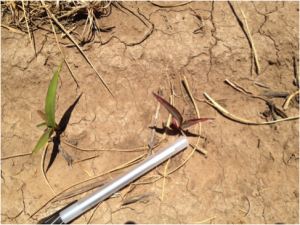 If you find a field with the purpling color and you have had cool conditions, it is advisable to re-check the field ever few days as warm weather resumes to track the return to normal colored tissue. Look for the newly emerging leaf to be green in color. As long as the plants are otherwise healthy yield potential is generally not compromised though it is possible individual plants might appear stunted.
If you find a field with the purpling color and you have had cool conditions, it is advisable to re-check the field ever few days as warm weather resumes to track the return to normal colored tissue. Look for the newly emerging leaf to be green in color. As long as the plants are otherwise healthy yield potential is generally not compromised though it is possible individual plants might appear stunted.
Could this be herbicide injury? In some cases when pre-emergent chloroacetamide herbicides (Dual, Lasso, Frontier) were applied, rain or irrigation may the chemical into the root zone. Under cool conditions the plants absorb more chemical, and some purpling may occur. Like the above scenario, the return of warm conditions and good growing conditions will diminish the symptoms and injury potential.
How does cool-induced purpling compare to conventional P deficiency? P-deficient sorghum plants are stunted, spindly, and dark green with overtones of dark red on the leaves. The red pigment first appears on older leaves and characteristically progresses upward toward younger leaves. Interveinal (between veins) tissue is sometimes red separated by green veins. On individual leaves redness first appears on the leaf tip and margins then progresses toward the base and midrib of the leaf.
Grain Sorghum Yield Components
Statewide
For any grain sorghum crop, the yield you realize across a field is a function of several factors. Of course, weather—especially rainfall—has a large impact. Your fertility program is an important key, especially for nitrogen. Whether economic thresholds of insects develop and how they may diminish your yield potential will be determined in how you control those pests.
But when a field of grain sorghum establishes, develops, and ultimately produces grain, where does the actual yield come from? Research demonstrates—as an average between irrigated, rainfed, and semi-arid dryland production—that the following yield factors in the sorghum plant itself generally establishes the contribution to grain sorghum yield:
· Seeds per head 63% of yield (higher in dryland)
· Heads per acre 30% of yield (higher for irrigated)
· Seed size/test weight 7% of yield
Seeds per head makes a proportionally higher contribution in limited rainfall dryland, up to 70% or more.
What does this mean for a producer? Is this something your management can influence? Though irrigation, if you have it, alters your production options considerably. Naturally you use plant population to increase your yield potential. This data suggests—strongly—that seeds per head is a greater contributor to yield than heads per acre. You can indeed have too many heads per acre (whether from planting too much seed or from significant tillering, which may not be in your best interest the drier it gets), and the end result is higher heads per acre can actually limit your potential grain yield.
The bottom line, especially for dryland and limited-rainfall dryland, is that grain sorghum’s ability to compensate for yield is more in the head (seed number) than in the number of heads per field. Knowing this enables producer to manage (reduce) risk by using modest and even low seeding rates in rainfed and especially in limited rainfall dryland production. These reduced seeding rates actually favor the factor that research demonstrates has a greater impact on grain yield: seeds per head.
Plant Height & Leaf Number – 2,4-D and Dicamba Applications
Statewide
Chemical labels for the use of 2,4-D and dicamba herbicides (e.g., Banvel, Clarity) stipulate specific growth stages, either as leaf number or height of the plant, for application. Both families of growth regulator herbicides have a reputation for potential injury on grain sorghum that can damage grain yield if applications are made at the wrong time, or too much of the herbicide contacts the plant, especially if it gets down in the whorl.
2,4-D (amine or ester formulations): Apply when grain sorghum is 6-15” tall (some labels say 5-15”), but if sorghum is 8” or taller, use drop nozzles to minimize chemical application to the plants.
Dicamba: Apply in the “spike” stage (meaning all sorghum emerged) but before 15” tall (and especially at 3-5 leaf stage—when determining the leaf stage, count the rounded-tip coleoptile leaf as leaf 1, and all subsequent leaves that have a collar, meaning the leaf is fully expanded). Use drops for grain sorghum ≥ 8” tall.
It is difficult sometimes to equate leaf stage and sorghum plant height. Leaf stage is more defined. The main consideration is that the growing point by about leaf stage 6 to 7 is now at the soil line and beginning to move up the stalk. In my experience, I equate leaf stage with about 8” tall. That growing point is very sensitive to these growth regulator herbicide applications! In fact, one former Kansas State University agronomist colleague told the Sorghum U attendees in January that 2,4-D is an inexpensive way to hurt your grain sorghum.
Summary Tips
- Be sure to follow label directions.
- Because of the sensitivity of grain sorghum to 2,4-D and dicamba applications, re-read the section of your label on the timing and growth stage for using these herbicide applications.
- If you are having doubts about whether you should still spray either of these herbicide families in grain sorghum, I suggest you don’t do it. This injury potential IS very real.
- If someone else is making spray applications for you, but you are close to the label restriction when to apply, ensure that your applicator doesn’t “get to it later” or “wait until next week,” and be willing to tell them it is too late and stop the planned application.
- If you believe you should not use either of these chemicals—growth stage too advanced, or you are simply risk-averse with these chemicals—consult your chemical dealer or Texas A&M AgriLife weed specialist for alternatives.
Grain Sorghum Growth & Development
Statewide
Sorghum growth and development was first detailed in an easy-to-read document from Kansas State University’s Dr. Richard Vanderlip about 1980. Dr. Vanderlip was the first person I ever worked for other than my Dad on the family farm. I was a student worker in his research group. We were each given a copy of “How a Sorghum Plant Develops,” and we were expected to read it several times. This classical document remains a standard for grain sorghum, http://www.ksre.ksu.edu/bookstore/pubs/s3.pdf
In 2001, Texas A&M AgriLife staff working with Dr. Vanderlip updated the 1980 document by incorporating some additional research along with explanation suited more to Texas than the Central High Plains. “Sorghum Growth and Development” (publication B-6137) was published in 2003. You can view, download, or print this document at http://agrilifebookstore.org (type the publication number in the search box).
The latter document includes more discussion on heat unit accumulation and explains how this drives grain sorghum growth. The Kansas State sorghum document places more emphasis on the nutrient accumulation of N, P, and K in the plant during the cropping season. For example, about 70% of the total nitrogen, or N, that grain sorghum needs is already in the plant at flowering; this is one reason why later N fertilizer applications have reduced impact on grain yield.
Each edition offers some unique points about how sorghum growth is a reflection of its environment. I re-read one or the other of these documents every three or four years as a refresher, especially since I have likely learned something new about grain sorghum. I encourage you to take a look at the documents to better understand your grain sorghum crop and how you may improve your management.
